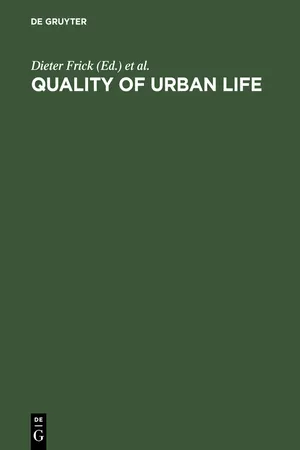
eBook - PDF
Quality of Urban Life
This is a test
- 272 pages
- English
- PDF
- Available on iOS & Android
eBook - PDF
Quality of Urban Life
Book details
Table of contents
Citations
Frequently asked questions
At the moment all of our mobile-responsive ePub books are available to download via the app. Most of our PDFs are also available to download and we're working on making the final remaining ones downloadable now. Learn more here.
Both plans give you full access to the library and all of Perlego’s features. The only differences are the price and subscription period: With the annual plan you’ll save around 30% compared to 12 months on the monthly plan.
We are an online textbook subscription service, where you can get access to an entire online library for less than the price of a single book per month. With over 1 million books across 1000+ topics, we’ve got you covered! Learn more here.
Look out for the read-aloud symbol on your next book to see if you can listen to it. The read-aloud tool reads text aloud for you, highlighting the text as it is being read. You can pause it, speed it up and slow it down. Learn more here.
Yes, you can access Quality of Urban Life by Dieter Frick, Hans W. Hoefert, Heiner Legewie, Rainer Mackensen, Rainer K. Silbereisen in PDF and/or ePUB format, as well as other popular books in Business & Business General. We have over one million books available in our catalogue for you to explore.
Information
Table of contents
- Part A: Overview: Quality of Urban Life
- Introduction
- 1. The New Urban Crisis
- 2. Psychological Aspects of the Quality of Urban Life
- 1 Introduction
- 2 The Meaning of the Quality of Urban Life
- 3 Issues in Describing the Physical Environment
- 4 Issues in the Definition of the Person
- 3. On Cities, Design, and People
- 1 The Future of Cities and the Role of Design
- 2 Death and Life of the Modern Movement
- 3 “Megastructura Labilis”
- 4 Post-Modern and Beyond
- 5 What Next?
- Part B: Social Networks
- Introduction
- 4. Social Networks and the Quality of Life
- 1 Time to Care
- 2 Social Support
- 5. Social Networks in Urban Neighbourhoods
- 1 The Impact of Urban Environment on Social Networks
- 2 Urban Environments and Social Networks: How to Study Network Properties in Large Populations?
- 3 Conclusions
- 6. Network Procedures
- 1 Growth of Network Studies
- 2 Macro and Micro Approaches
- 3 The Contextualization of Social Networks
- 4 The Features of the Network
- 5 Basis of the Determinancy of Social Action
- 6 Data Collection
- 7 The Manchester Homeless Families Study
- 8 The Analysis of the Data
- 9 Conclusions
- Part C: Ethnic Minorities
- Introduction
- 7. Acculturation and Stress Among Immigrants and Later Generation Individuals
- 1 Introduction
- 2 A Model of Acculturation
- 3 Psychological Stress: A Model and Some Findings
- 4 Some Observations from the Data
- 5 Conclusions
- 8. The Pattern of Acculturation amongst Asian and Caribbean Descended Youth in Britain
- 1 The Limitations of Acculturation Theory
- 2 The Asian Immigrants to Great Britain
- 3 The West Indian Immigrants to Great Britain
- 4 Conclusions
- 9. Acculturation in Urban Areas: Migrant Workers and the Settlement of Turks in West Berlin
- 1 Introduction
- 2 Models of Acculturation and Assimilation
- 3 Towards a More Differentiated View
- 4 The Urban Concentration of Turkish Settlement Patterns
- 5 The Cultural Diversity of the Turkish Enclave in West Berlin
- 6 Research Findings
- 7 Occupational Orientations of the Turkish Youth in West Berlin/Acculturation?
- 8 Work Values
- 9 Future Orientations Towards Working and Living
- Part D: Man – Environment Relations
- Introduction
- 10. The Use and Design of Open Spaces in Urban Neighbourhoods
- 1 Introduction
- 2 The Conceptual Framework
- 3 Activities and Activity Systems
- 4 Settings and Systems of Settings
- 5 Supportive Environments
- 6 The Neighbourhood as Setting System
- 7 An Example: Pedestrian Activities
- 8 Design and Research
- 11. Aesthetic, Communication and Use: Perspectives for Urban Open Spaces
- 12. An Ecological Approach to Urban Environment Perception
- 1 Introduction
- 2 Methodological Aspects
- 3 Type one Studies: Perceptions of the Whole Urban Environment
- 4 Type two Studies: Perception of the Quality of the Residential Environment in the Sample Area
- 5 Type three Studies: Inhabitants’ and Temporary Visitors’ Cognitive Representation of the City
- 6 Conclusions
- 13. Psychological Identity of and Identification With Urban Neighbourhoods
- 1 Introduction
- 2 Design of the Research Project
- 3 Identity of and Identification with One’s Neighbourhood as Reflected in Subjective Presentations
- 4 Identity Markers in the Physical Environment
- 5 Identification with the Neighbourhood qua Social Environment
- 6 Conclusions
- Part E: Mental Health
- Introduction
- 14. New York City’s Open Space System. The Process of Evolution
- 15. The Reform of Health and Psychiatric Services in Relation to the Quality of Urban Life. Experiences in the Region of Piedmont and in the City of Turin
- 1 Introduction
- 2 Decentralization of Mental Health Services (MHS) in Piedmont and in the City of Turin
- 3 Transformations and Crises
- 4 Dismantling the Psychiatric Hospitals in Turin
- 16. From the Social Movement Towards the Socio-Cultural Movement. The Example of Amsterdam
- List of Authors
- Author Index